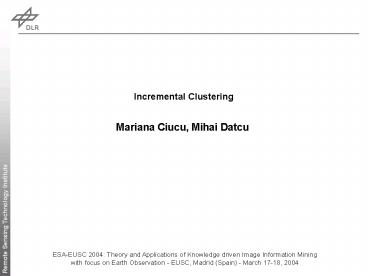The Development of a Scientific Permanent Scatterer System PowerPoint PPT Presentation
1 / 24
Title: The Development of a Scientific Permanent Scatterer System
1
Incremental Clustering Mariana Ciucu, Mihai
Datcu
ESA-EUSC 2004 Theory and Applications of
Knowledge driven Image Information Mining with
focus on Earth Observation - EUSC, Madrid (Spain)
- March 17-18, 2004
2
Cluster analysis is the art of finding groups in
data
3
EXAMPLE DATA CLUSTERING
4
EXAMPLE DATA CLUSTERING
5
EXAMPLE DATA CLUSTERING
6
EXAMPLE DATA CLUSTERING
7
APPLICATIONS IMAGE ANALYSIS
- IMAGE INTERPRETATION
- classification
- sensor/data fusion
- scene understanding
8
APPLICATIONS DATA MINING
- IMAGE INFORMATION MINING
- find ceratian images in an archive
- explore the image information content
- discover scene structures or dynamics by
exploring image collections
9
APPLICATIONS INTERNET SEARCH ENGINES
- SEMANTIC WEB
- find similar documents
- find key-structures in documents
- understand the nature of documents
- document heterogeneous data
10
CHALLANGES
- how many clusters ?
- which is the shape of the clusters ?
- how to cluster heterogeneous data ?
- how to compute it fast ?
11
AutoClass
- base mixture model
- Bayesian estimation of
- optimal classes
12
k - means
- fast
- imposed no. of clusters
- unbalanced clusters
13
Clustering and DataBase index systems
clustering
data
DBMS
14
The need for incremental clustering
- DB items might get added and deleted over time
- These changes should be reflected in the
partition generated without significantly
affecting the current clusters. - Incremental clustering algorithm has three
steps - Assign the first datum to a cluster.
- Read the next datum, and assign this item to one
of the existing clusters or generate a new
cluster. This assignment is done based on some
similarity measure over the data space. - Repeat step 2 until all the data set is
clustered.
15
Incremental clustering State of the art
- Hierarchical methods and density - based methods
- BIRCH Balanced Iterative Reducing and
Clustering using Hierarchies - CURE Clustering Using Representatives
- DBSCAN Density-Based Spatial Clustering of
Applications with Noise - OPTICS Ordering Pints To Identify the
Clustering Structure - DENCLUE DENsity-based CLUstEring
16
Incremental clustering State of the art
- Grid - based methods
- STING STatistical INformation Grid approach (
grid-based and density-based algorithm) - CLIQUE Clustering high-dimensional space
(density-based grid-based clustering) - WaveCluster Clustering using wavelet
transformation
17
Incremental clustering State of the art
- Daniel Barbara, Ping Chen, Using the Fractal
Dimension to Cluster Datasets, Oct. 1999 - grid-based clustering fractal analysis of the
data - Fractal Clustering (FC) places points
incrementally in the cluster for witch the change
in the fractal dimension after adding the point
is the last.
18
Incremental clustering State of the art
- Chia H. Yeh Chung. J. Kuo, Iteration-free
clustering algorithm for nonstationary image
database, IEEE Transactions on Multimedia, vol.
5, no.2, pp. 223-236, Jun. 2003. - Iteration-free clustering algorithm (IFC) is
based on Lagrangian function for adapting the
existing indexing structure without reapplying
the clustering algorithm to database.
19
Grid based clustering
20
Adaptive grid clustering
- Similar to vector quantization but dynamic
adapation to data model - Merging / Splitting strategies
- 1. density and neighbors
- 2. densty and ? densities ( neighborhood )
afer clustering,if we want 4 clusters
before clustering
Neighbor searching and merging to existing cluster
21
Evaluation
Classification
22
Evaluation
Classification
23
Proabilitsic search
24
SUMMARY
- Incremental clustering is a key issue for IIM
- Adaptive grid is presently a working solution
- Further work is done
- Evaluation on growing massive data sets
- Understanding data models
- Adaptation methods

